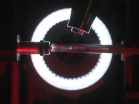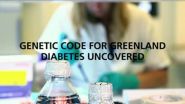(Press-News.org) PRINCETON, N.J.—A study that would track the health of 100,000 babies to age 21 has been put on hold following the release of an assessment report issued June 16 by the National Research Council and Institute of Medicine (IOM).
While the congressionally mandated report endorses several aspects of the proposed study design of the National Children's Study (NCS), the authors – including Sara McLanahan, the William S. Tod Professor of Sociology and Public Affairs at Princeton University's Woodrow Wilson School of International and Public Affairs – are critical of the sampling design and study content.
Authorized by the Children's Health Act of 2000, NCS originated after a request by Congress to examine how environmental factors, like social settings and pollution, influence the long-term health of children. The study, managed by an office at the Eunice Kennedy Shriver National Institute of Child Health and Human Development (NICHD), will recruit 100,000 women and their unborn babies and follow them through age 21. In March 2013, Congress requested that IOM write an assessment of the study design.
While the authors support many aspects of the proposed design, they particularly do not endorse the study's plan to recruit half of the children at birth. Doing so would skew the data obtained, the authors say, due to the scientific importance of prenatal exposures on child development. Instead, the authors recommend recruiting all 95,000 mothers during pregnancy, which can be done for the same cost – if 10,000 "convenience samples" are dropped.
"Collecting data on mothers-to-be during the prenatal phase is important and could provide information of paramount importance related to the health, growth and development of U.S. children," said McLanahan, who also directs the Bendheim-Thoman Center for Research on Child Wellbeing. "If carried out successfully, the survey has the potential to be the most comprehensive study of child health and development in the world."
The report authors endorse several of the design features, however, including:
The use of a national equal probability sample for a large cohort of births
The concept of the study as a data collection platform with a focus on health and development guided by exemplar scientific hypotheses
The inclusion of siblings born within a four-year window
The collection and storage of biological and environmental samples to permit subsequent analysis
Among its recommendations, the report urges the NICHD to enhance the scientific expertise of the NCS program office by recruiting and contracting with experts in relevant fields from within the National Institutes of Health, other federal agencies and organizations outside of government.
In addition, NICHD should establish an authoritative multidisciplinary oversight structure to review the program office's decisions and establish a mechanism for regular, independent outside review by the qualified organization or a study section like those in NIH.
"Asthma, ADHD and obesity are all on the rise in this country, and probably caused by environmental factors," said McLanahan. "The NCS is designed to collect an unprecedented volume of data on the kinds of environmental and psycho-social exposures both before and after children are born. Moreover, its large size enables the NCS to support analyses of the underlying causes of health disparities across groups defined by race, ethnicity and socioeconomic status, which is an important national health problem identified in the Children's Health Act of 2000."
INFORMATION:
The study was sponsored by the U.S. Department of Health and Human Services. The National Research Council is the principal operating arm of the National Academy of Sciences, of which McClanahan is a member.
Additional authors include Greg J. Duncan, University of California, Irvine; Dean B. Baker, University of California, Irvine; Paul Biemer, Mathematica Policy Research Inc.; Ana V. Diez Roux; Barbara Lepidus Carlson, Mathematica Policy Research Inc.; Virginia Lesser, Oregon State University; Marie C. McCormick, Harvard School of Public Health; George Saade, Univeristy of Texas Medical Branch; S. Lynne Stokes, Southern Methodist University; and Leonardo Trasande, New York University School of Medicine. The study director is Nancy Kirkendall.
The report, "The National Children's Study 2014: An Assessment," was first made available June 16. The report is available from the National Academics Press on the Internet at http://www.nap.edu or by calling 202-334-3313 or 1-800-624-6242. Reporters may obtain a copy by emailing Dana Korsen, media officer, at news@nas.edu.
View the original report: http://www.nap.edu/catalog.php?record_id=18826
For more WWS Research Briefs, visit http://wws.princeton.edu/faculty-research/research-briefs.
Proposed children's study needs refinement, report finds
2014-06-18
ELSE PRESS RELEASES FROM THIS DATE:
False negative results found in prognostic testing for breast cancer
2014-06-18
A recent study evaluating HER2 testing in a large cohort of women with breast cancer found important limitations in the conventional way HER2 testing is performed in the US and internationally.
Dartmouth-Hitchcock Norris Cotton Cancer Center physicians and researchers retested tumor samples from a large group of women and found that 22 out of 530 women had their tumor type incorrectly classified. They reported their findings in a publication titled "Assessing the Discordance Rate between Local and Central HER2 Testing in Women with Locally Determined HER2-Negative Breast ...
New Stanford blood test identifies heart-transplant rejection earlier than biopsy can
2014-06-18
Stanford University researchers have devised a noninvasive way to detect heart-transplant rejection weeks or months earlier than previously possible. The test, which relies on the detection of increasing amounts of the donor's DNA in the blood of the recipient, does not require the removal of any heart tissue.
"This test appears to be safer, cheaper and more accurate than a heart biopsy, which is the current gold standard to detect and monitor heart-transplant rejection," said Stephen Quake, PhD, professor of bioengineering and of applied physics. "We believe it's likely ...
How a new approach to funding Alzheimer's research could pay off
2014-06-18
More than 5 million Americans suffer from Alzheimer's disease, the affliction that erodes memory and other mental capacities, but no drugs targeting the disease have been approved by the U.S. Food and Drug Administration since 2003. Now a paper by an MIT professor suggests that a revamped way of financing Alzheimer's research could spur the development of useful new drugs for the illness.
"We are spending tremendous amounts of resources dealing with this disease, but we don't have any effective therapies for it," says Andrew Lo, the Charles E. and Susan T. Harris Professor ...
Maybe birds can have it all: Dazzling colors and pretty songs
2014-06-18
ITHACA, N.Y. – A study of one of the world's largest and most colorful bird families has dispelled a long-held notion, first proposed by Charles Darwin, that animals are limited in their options to evolve showiness. The study – the largest of its kind – was published today in the Proceedings of the Royal Society B.
The natural world is full of showstoppers – birds with brilliant colors, exaggerated crests and tails, intricate dance routines, or virtuosic singing. But it's long been thought that these abilities are the result of trade-offs. For a species to excel in one ...
Demand for diabetes, thyroid care outpaces supply of endocrinologists
2014-06-18
Washington, DC—As more people are diagnosed with diabetes and other hormone conditions, a growing shortage of endocrinologists could force patients to wait longer to see a doctor, according to a new Endocrine Society workforce analysis published in the Journal of Clinical Endocrinology & Metabolism (JCEM).
Endocrinologists are specially trained physicians who diagnose diseases related to the glands. They specialize in treating diabetes, obesity, osteoporosis, thyroid disorders, adrenal diseases, and a variety of other conditions related to hormones.
The analysis found ...
Scientists take first dip into water's mysterious 'no-man's land'
2014-06-18
Scientists at the Department of Energy's SLAC National Accelerator Laboratory have made the first structural observations of liquid water at temperatures down to minus 51 degrees Fahrenheit, within an elusive "no-man's land" where water's strange properties are super-amplified.
The research, made possible by SLAC's Linac Coherent Light Source (LCLS) X-ray laser and reported June 18 in Nature, opens a new window for exploring liquid water in these exotic conditions, and promises to improve our understanding of its unique properties at the more natural temperatures and ...
UEA researchers discover Achilles' heel in antibiotic-resistant bacteria
2014-06-18
Scientists at the University of East Anglia have made a breakthrough in the race to solve antibiotic resistance.
New research published today in the journal Nature reveals an Achilles' heel in the defensive barrier which surrounds drug-resistant bacterial cells.
The findings pave the way for a new wave of drugs that kill superbugs by bringing down their defensive walls rather than attacking the bacteria itself. It means that in future, bacteria may not develop drug-resistance at all.
The discovery doesn't come a moment too soon. The World Health Organization has warned ...
Identifying opposite patterns of climate change between the middle latitude areas
2014-06-18
Korean research team revealed conflicting climate change patterns between the middle latitude areas of the Northern and Southern Hemispheres in relation to glacial and interglacial cycles which have been puzzled for the past 60 years.
Doctor Kyoung-nam Jo from the Quaternary Geology Department of the Korea Institute of Geoscience and Mineral Resources(KIGAM) revealed a clue for solving the riddle of past global climate change in his paper titled 'Mid-latitudinal interhemispheric hydrologic seesaw over the past 550,000 years' which was featured in the journal Nature.
This ...
Evolutionary biology: Why cattle only have 2 toes
2014-06-18
During evolutionary diversification of vertebrate limbs, the number of toes in even-toed ungulates such as cattle and pigs was reduced and transformed into paired hooves. Scientists at the University of Basel have identified a gene regulatory switch that was key to evolutionary adaption of limbs in ungulates. The study provides fascinating insights into the molecular history of evolution and is published by Nature today.
The fossil record shows that the first primitive even-toed ungulates had legs with five toes (=digits), just like modern mice and humans. During their ...
Scientists break the genetic code for diabetes in Greenland
2014-06-18
VIDEO:
New Danish genetics research explains the high incidence of type 2 diabetes in the Greenlandic population. The ground-breaking findings have just been published in the prestigious scientific journal Nature....
Click here for more information.
A spectacular piece of detective work has mapped a special gene variant among Greenlanders which plays a particularly important role in the development of type 2 diabetes. The results have been published in Nature and can be ...


